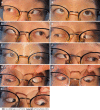Acute acquired concomitant esotropia with congenital paralytic strabismus: A case report
- PMID: 37900252
- PMCID: PMC10601007
- DOI: 10.12998/wjcc.v11.i27.6476
Acute acquired concomitant esotropia with congenital paralytic strabismus: A case report
Abstract
Background: An unusual case of acute acquired concomitant esotropia (AACE) with congenital paralytic strabismus in the right eye is reported.
Case summary: A 23-year-old woman presented with complaints of binocular diplopia and esotropia of the right eye lasting 4 years and head tilt to the left since 1 year after birth. The Bielschowsky head tilt test showed right hypertropia on a right head tilt. She did not report any other intracranial pathology. A diagnosis of AACE and right congenital paralytic strabismus was made. Then, she underwent medial rectus muscle recession and lateral rectus muscle resection combined with inferior oblique muscle myectomy in the right eye. One day after surgery, the patient reported that she had no diplopia at either distance or near fixation and was found to be orthophoric in the primary position; furthermore, her head posture immediately and markedly improved.
Conclusion: In future clinical work, in cases of AACE combined with other types of strabismus, we can perform conventional single surgery for both at the same time, and the two types of strabismus can be solved simultaneously.
Keywords: Acute acquired concomitant esotropia; Case report; Congenital paralytic strabismus; Simultaneous surgery; Superior oblique paralysis.
©The Author(s) 2023. Published by Baishideng Publishing Group Inc. All rights reserved.
Conflict of interest statement
Conflict-of-interest statement: All the authors declare that they have no conflicts of interest to disclose.
Figures




References
-
- Burian HM, Miller JE. Comitant convergent strabismus with acute onset. Am J Ophthalmol. 1958;45:55–64. - PubMed
-
- Vagge A, Giannaccare G, Scarinci F, Cacciamani A, Pellegrini M, Bernabei F, Scorcia V, Traverso CE, Bruzzichessi D. Acute Acquired Concomitant Esotropia From Excessive Application of Near Vision During the COVID-19 Lockdown. J Pediatr Ophthalmol Strabismus. 2020;57:e88–e91. - PubMed
-
- Kushner BJ. Ocular causes of abnormal head postures. Ophthalmology. 1979;86:2115–2125. - PubMed
-
- Schreuders J, Thoe Schwartzenberg GW, Bos E, Versteegh FG. Acute-onset esotropia: should we look inside? J Pediatr Ophthalmol Strabismus. 2012;49 Online:e70–e72. - PubMed
Publication types
LinkOut - more resources
Full Text Sources

